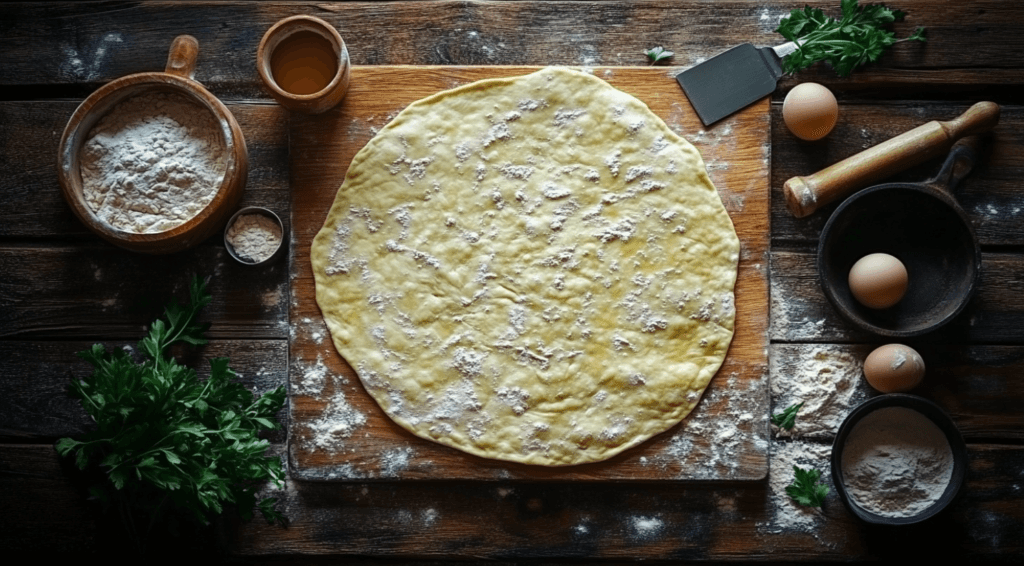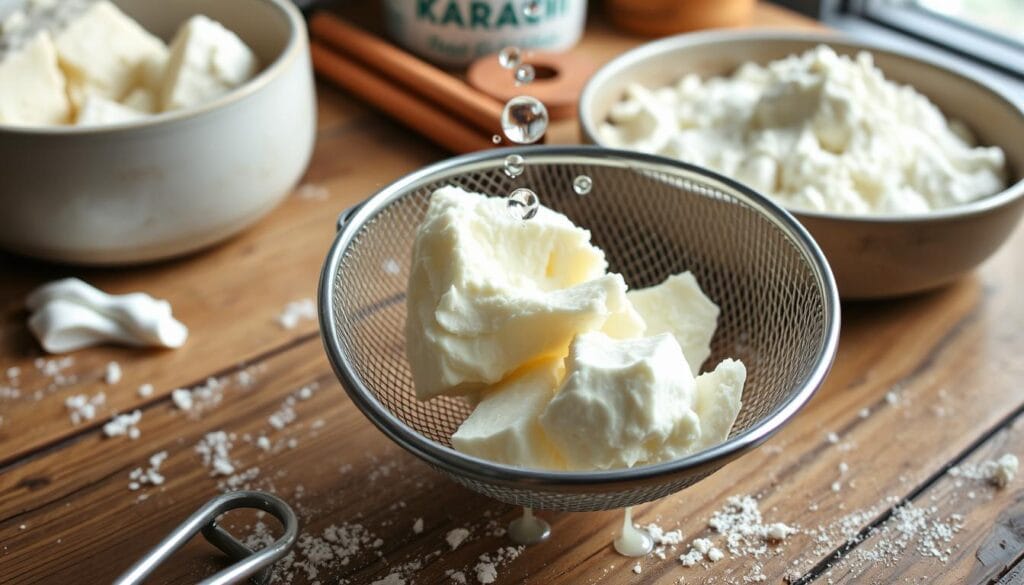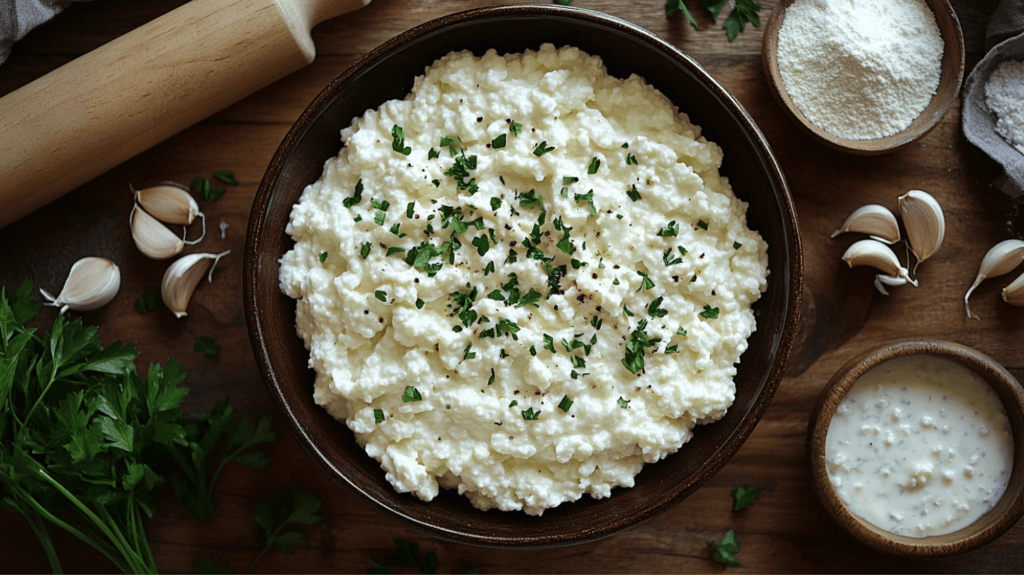Ever looked forward to a crispy cottage cheese flatbread, only to find it soggy? You’re not alone. Getting the right mix of moisture and crispness is tricky. But, with the right tips, you can get it just right.
We’ll look at why your flatbread might be soggy. Then, we’ll share easy ways to make it crispy again.
Understanding Cottage Cheese Flatbread Basics
Making tasty cottage cheese flatbread begins with knowing the main ingredients. You need full-fat cottage cheese, eggs, and a bit of garlic powder and Italian seasoning. These ingredients mix well to create a light, fluffy, and crispy flatbread with a chewy center.
Key Ingredients and Their Roles
Full-fat cottage cheese is the main ingredient, giving the flatbread a creamy texture and strong taste. Eggs act as the glue, keeping the flatbread together and making it soft inside. Garlic powder and Italian seasoning add flavor, making the dish even better.
Perfect Texture Characteristics
A great cottage cheese flatbread is light, fluffy, and crispy on the outside. It should also be chewy inside. Getting this right depends on the batter’s consistency, which is very important.
Importance of Proper Consistency
The batter’s consistency is key for the right texture. If it’s too thin, the flatbread will be soggy. If it’s too thick, it will be dense. Finding the perfect mix is essential for a great flatbread.
Why Is My Cottage Cheese Flatbread Soggy
Achieving a crispy cottage cheese flatbread can be tricky. Sogginess often results from excess moisture, incorrect ingredient ratios, or baking issues.
Drain the cottage cheese well using a cheesecloth or coffee filter.
The right ingredient mix is key—too much cottage cheese and not enough eggs make the dough too wet. Adjust the ratios for crispiness.
Baking issues, like low oven temperature or insufficient time, can cause sogginess. Bake at 400°F (200°C) for 35–40 minutes for a crispy texture.
Managing moisture, ingredients, and baking properly will give you the perfect flatbread.

Common Mistakes When Making Cottage Cheese Flatbread
Making the perfect cottage cheese flatbread is tricky. Even a small mistake can make it soggy or dense. To make sure your flatbread is light and tasty, watch out for these common errors.
Incorrect Ingredient Ratios
The right mix of ingredients is key for the flatbread’s texture. Too much cottage cheese or not enough eggs makes it heavy. The wrong flour-to-liquid ratio can make it flat and crumbly.
Stick to the right amounts: 1 cup cottage cheese, 2 cups flour, 1-2 teaspoons baking powder, and a pinch of salt. This mix helps get the perfect texture.
Temperature Control Issues
Getting the oven temperature right is crucial. Baking too hot can burn the outside before the inside is cooked. Baking too cold makes it soggy and doesn’t get the golden crust you want.
The best oven temperature for cottage cheese flatbread is between 350°F and 375°F (175°C to 190°C). This ensures it bakes evenly and gets that crispy, tasty crust.
Preparation Technique Errors
Small mistakes can affect the flatbread’s quality. Not draining the cottage cheese enough makes the dough too wet, while overbaking or underbaking can make it tough or undercooked.
Pay attention to every step, from draining to baking time. This will help you make the perfect flatbread.
By avoiding common mistakes, you’ll master crispy, delicious cottage cheese flatbread.
Essential Equipment and Tools for Perfect Flatbread
To make perfect cottage cheese flatbread, you’ll need a few key tools. A blender or food processor is essential for smoothly blending the cottage cheese, eggs, and spices, preventing sogginess.
A greased baking sheet or parchment paper prevents sticking and ensures even baking. An oven thermometer ensures the right temperature for crispiness.
A spatula or turner helps transfer the flatbread without breaking it.
With the right tools, you’ll achieve the perfect texture and taste every time.
| Essential Tools for Perfect Flatbread | Description |
|---|---|
| Blender or Food Processor | Ensures smooth, even blending of ingredients |
| Baking Sheet or Parchment Paper | Prevents sticking and ensures even baking |
| Oven Thermometer | Maintains accurate oven temperature for desired texture |
| Spatula or Turner | Allows for easy transfer of delicate flatbread |

Proper Draining Techniques for Cottage Cheese
To get the right texture for cottage cheese flatbread, you need to drain it well. Too much moisture makes it soggy. Use good draining methods to get rid of extra liquid and make your cottage cheese ready for your recipe.
Methods to Remove Excess Moisture
Here are a few easy ways to drain cottage cheese:
- Use a fine-mesh strainer or cheesecloth to separate the curds from the liquid whey. Gently press the cottage cheese with the back of a spoon to extract as much moisture as possible.
- Place the cottage cheese in a clean kitchen towel or paper towels and gently squeeze out the excess liquid. This method is especially helpful for removing stubborn moisture.
- For an extra-dry cottage cheese, consider placing it in a mesh strainer or colander and refrigerating for 30 minutes to an hour, allowing the remaining liquid to drain away.
Time-Saving Draining Tips
If you’re in a hurry, here are some quick draining tips:
- Use a salad spinner to quickly remove moisture from the cottage cheese. The centrifugal force will extract excess liquid in a matter of seconds.
- Microwave the cottage cheese for 30 seconds to 1 minute, then drain and repeat as needed. The heat will help release the moisture, making it easier to drain.
- Spread the cottage cheese on a clean, absorbent surface, such as a paper towel-lined baking sheet, and let it sit for 10-15 minutes before using. The paper towels will wick away the excess liquid.
By using these draining techniques, your cottage cheese flatbread will always be crisp and tasty.

Temperature and Timing: Critical Factors
To make the perfect cottage cheese flatbread, you need to focus on the baking temperature and timing. The ideal temperature is 350°F (180°C). Make sure your oven is at this exact temperature for the best results.
The baking time is also key. It should be between 35 to 40 minutes. This time helps the flatbread get a golden-brown crust and stay soft inside. Don’t open the oven door during this time. It can mess up the heat and make the flatbread soggy.
| Baking Temperature | Baking Time |
|---|---|
| 350°F (180°C) | 35-40 minutes |
By watching the temperature and timing closely, you can make the perfect cottage cheese flatbread every time. Even small changes in these areas can greatly affect your flatbread’s texture and look.
The Role of Proper Ingredient Selection
Choosing the right ingredients is key to making a great cottage cheese flatbread. Using fresh, high-quality parts can change everything. It helps get the perfect texture and taste.
Choosing the Right Cottage Cheese
The type of cottage cheese matters a lot. Full-fat cottage cheese works best. It has creamy curds that make the flatbread richer and tastier.
Egg Quality and Consistency
Eggs are also very important. Fresh, good eggs help the flatbread stick together well. They make it have the right texture.
It’s important to pick the same ingredients every time. Using the same cottage cheese and eggs makes the flatbread better. This way, you always get a delicious, crispy flatbread.
| Ingredient | Recommendation | Rationale |
|---|---|---|
| Cottage Cheese | Full-fat or 2% Variety | Full-fat cottage cheese provides a richer, more satisfying texture and flavor. |
| Eggs | Fresh, high-quality | Fresh eggs contribute to the binding and structure of the flatbread, ensuring a cohesive texture. |
Best Practices for Storage and Reheating
Keeping your homemade cottage cheese flatbread fresh is key. Follow these tips to enjoy it at its best. Whether you’re prepping meals ahead or enjoying it later, these practices will help.
Storing Cottage Cheese Flatbread
Let your flatbread cool down completely. Then, wrap it tightly in plastic wrap or aluminum foil. This keeps it moist and prevents drying out. Your flatbread can stay fresh for up to 3 days in the fridge.
To store it longer, freeze the flatbread for up to 1 month. Wrap it well in an airtight container or freezer-safe bag to avoid freezer burn.
Reheating Techniques
The best way to reheat your flatbread is in the oven or toaster oven. Preheat to 350°F (175°C). Place the flatbread on the rack or a baking sheet. Reheat for 5-10 minutes until it’s warm and crispy.
Don’t reheat in the microwave. It can make the flatbread soggy. The oven or toaster oven keeps it crispy.
Meal Prep Strategies
Cottage cheese flatbread is great for meal prep. Make a batch at the start of the week. Enjoy it as a quick, protein-rich breakfast, lunch, or snack all week.
Before storing, slice or cut the flatbread into smaller pieces. This makes reheating and portioning easier. Add your favorite toppings, dips, or fillings for a tasty meal.

Troubleshooting Texture Problems
Getting the right texture for your cottage cheese flatbread is tricky. You might face issues like sogginess, dryness, or uneven cooking. But don’t worry, there are quick fixes to solve these problems and make your flatbread perfect.
Common Texture Issues
- Sogginess: A moist or undercooked flatbread can be soggy and unappealing.
- Dryness: A flatbread that’s too dry can be tough to chew.
- Uneven Cooking: When some parts are undercooked and others are burnt, it messes up the texture.
Quick Solutions and Fixes
To fix these texture problems, try these adjustments:
- Adjust Baking Time: If it’s soggy, bake it longer to dry out. If it’s dry, bake it less.
- Check Ingredient Ratios: Make sure you have the right mix of cottage cheese, eggs, and other ingredients. The wrong mix can cause texture issues.
- Optimize Oven Temperature: Ensure your oven is at the right temperature. Wrong heat can cause uneven cooking.
- Address Soggy Flatbread: For soggy flatbread, drain the cottage cheese better or use less liquid.
With these quick fixes, you can solve many texture problems. This way, your cottage cheese flatbread will always be crisp and tasty.
Professional Tips for Crispy Flatbread
To get your cottage cheese flatbread crispy, use some pro tips. First, heat your oven with a baking stone or steel inside. This hot surface is key for that crunchy texture you want.
Before baking, lightly brush the flatbread with olive oil. It adds flavor and helps the outside get brown and crispy.
After baking, let the flatbread cool down completely before cutting it. This step is important for the inside to dry out and the crust to set. For more crunch, sprinkle dried herbs and seasonings on top before serving.
- Use a preheated baking stone or steel for extra crispiness
- Brush the flatbread with olive oil before baking
- Allow the flatbread to cool completely before slicing
- Experiment with different seasonings and add-ins for flavor
| Tip | Benefit |
|---|---|
| Preheated baking surface | Helps create a crispy crust |
| Olive oil brushing | Adds flavor and enhances browning |
| Cooling before slicing | Allows interior moisture to redistribute for a firmer texture |
| Seasoning experimentation | Customizes the flavor profile while maintaining the desired texture |
Follow these crispy flatbread tips to make your cottage cheese flatbread better. You’ll get a delicious result that’s perfect for any meal.
Making Ahead and Meal Prep Strategies
Cottage cheese flatbread is great for meal prep. Make batches ahead, cool, and store for quick meals. Freezing individual servings is ideal for busy days.
It’s versatile too—top with avocado, smoked salmon, or fresh fruit with honey for a healthy meal.
For storage, keep in the fridge for up to 3 days or freeze portions for up to 2 months.
Reheat in the oven or toaster oven to maintain crispiness. With some prep, enjoy this meal all week.
Key Tips for Meal Prepping Cottage Cheese Flatbread:
- Prepare multiple batches in advance for easy access throughout the week
- Cool the flatbread completely before storing it to prevent sogginess
- Pre-portion individual servings and freeze for up to 2 months
- Reheat the flatbread in the oven or toaster oven to maintain texture
- Experiment with a variety of toppings and fillings to keep meals interesting
Embracing meal prep with cottage cheese flatbread offers a healthy, tasty option anytime. With some planning, you’ll always have a nutritious meal ready, even when you’re busy.
Conclusion
Cottage cheese flatbread is a healthy, high-protein alternative to regular bread. It’s crispy and delicious with the right techniques. Experiment with different toppings and seasonings for healthy meals.
Packed with 2.3 grams of protein per slice, it’s ideal for keto, low-carb, and gluten-free diets. The recipe is simple and easy, perfect for any cook.
Keep perfecting your flatbread by focusing on draining, temperature, and quality ingredients. Soon, you’ll enjoy this versatile dish for breakfast, snacks, and more. Start making cottage cheese flatbread and savor the results.
FAQ
What are the key ingredients for making cottage cheese flatbread?
To make cottage cheese flatbread, you need full-fat cottage cheese, eggs, and optional seasonings. These can include garlic powder and Italian herbs.
What is the ideal texture for cottage cheese flatbread?
The perfect cottage cheese flatbread is light, fluffy, and crispy. It should also have a chewy interior.
Why is my cottage cheese flatbread turning out soggy?
Sogginess can come from too much moisture in the cottage cheese. It can also happen if the ingredients are not in the right ratio. Not baking it long enough or at the right temperature can also cause it.
What are the common mistakes people make when making cottage cheese flatbread?
Mistakes include using the wrong amount of cottage cheese and eggs. Not draining the cottage cheese well is another error. Baking it for too short a time or at the wrong temperature is also common. Taking it out of the oven too soon is another mistake.
What equipment and tools are essential for making perfect cottage cheese flatbread?
You’ll need a blender or food processor, a greased baking sheet or parchment paper, and an oven thermometer. These tools are crucial for success.
How do I properly drain the cottage cheese to prevent sogginess?
To drain cottage cheese, use a fine-mesh strainer or cheesecloth. Press it gently to speed up the process. This helps keep the texture right.
What is the recommended baking temperature and time for cottage cheese flatbread?
Bake at 350°F (180°C) for 35-40 minutes. Make sure your oven is preheated well. Don’t open the oven door during baking for even results.
What type of cottage cheese and eggs should I use for the best results?
Use full-fat or 2% cottage cheese for better results. Choose fresh, high-quality eggs for the best binding and texture.
How should I store and reheat cottage cheese flatbread?
Cool the flatbread completely before wrapping it in plastic wrap or foil. Store it in the fridge for up to 3 days or freeze for a month. Reheat in an oven or toaster oven to stay crispy. Avoid microwaving to prevent sogginess.
How can I troubleshoot common texture issues with my cottage cheese flatbread?
For texture problems, try adjusting the baking time or ensuring the right ingredient ratios. Use the correct oven temperature. For soggy flatbread, bake it longer or drain excess moisture.

